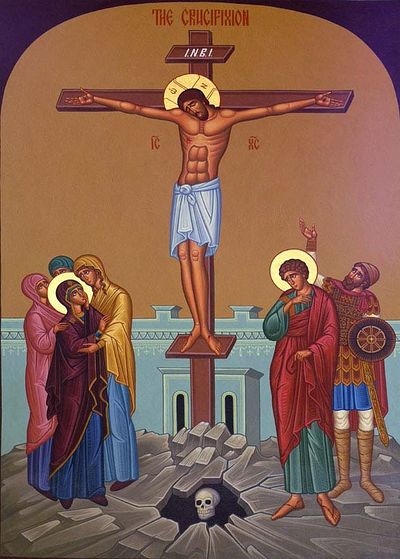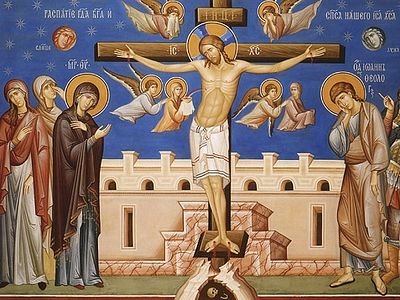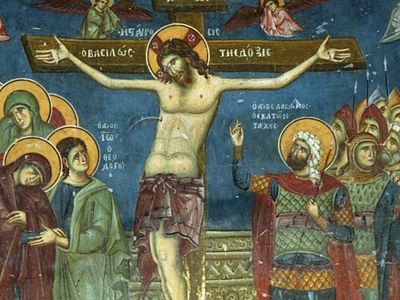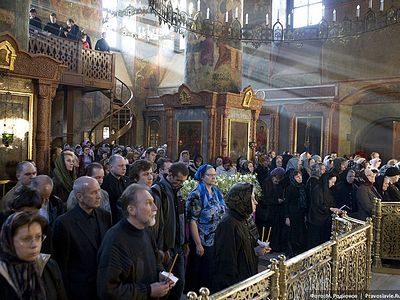On Thursday evening, the Matins service of Holy Friday is served. This service is also called the Service of the Twelve Gospels, because there are twelve Gospel passages relating to the Lord’s passion and crucifixion. In the Russian tradition, the candles held lit during this service are taken home, the flame used to light the icon lamps as a blessing.
On Friday morning The Great [Royal] Hours are served.
About the Icon: The Crucifixion of Our Lord
Christ is nailed to the Cross; His right side is pierced and the wound flows with blood and water.
The Theotokos is depicted on the left with a halo.
The three women depicted together with the Theotokos are Saint Mary Magdalene, Mary the mother of James and Joses, and the mother of Zebedee's children (Matthew 27:56)
Saint John the Beloved Disciple is on the immediate right of the cross.
Saint Longinus the Centurion is on the extreme right; he is the Roman centurion mentioned in Saint Mark's Gospel account of the Crucifixion (Mark 15:39).
The Inscription on the top bar of the Cross is the inscription I.N.B.I., the initials of the Greek words meaning "Jesus of Nazareth, King of the Jews."
The Skull at the foot of the Cross. “Golgotha”, the Mount of the Crucifixion, means “the place of the skull." Tradition relates that the Cross of Christ stood directly above the grave of Adam.
Crucifixion of Our Lord. References:
First Hour:
Zechariah 11:10-13
Galatians 6:14-18
Matthew (27:1-56)
Third Hour:
Isaiah 50:4-11
Romans 5:6-10
Mark 15:16-41
Sixth Hour:
Isaiah 52:13-15, 54:1-12
Hebrews 2:11-18
Luke 23:32-49
Ninth Hour:
Jeremiah 11:18-23, 12:1-5, 9:11, 14-15
Hebrews 10:19-31
John 19:23-37
Explanation of the Service:
Each of the four Hours bears a numerical name, derived from one of the major daylight hours or intervals of the day as they were known in antiquity: the First (corresponding to sunrise); the Third (midmorning or 9 a.m.); the Sixth (noonday); and the Ninth (mid-afternoon or 3 p.m.).
Each Hour has a particular theme, and sometimes even a sub-theme, based upon some aspects of the Christ-event and salvation history. The general themes of the Hours are the coming of Christ, the true light (First); the descent of the Holy Spirit (Third); the passion and crucifixion of Christ (Sixth); the death and burial of Christ (Ninth).
The central prayer of each Hour is the Lord’s Prayer. In addition, each Hour has a set of three Psalms, hymns, a common prayer (Christ our God, worshiped and glorified...) and a distinctive prayer for the Hour.
Slight variations occur in the Service of the Hours on feast days as well as on fast days. For example, in the place of the regular troparia, the apolytikia of the feast are read; or in the case of the Great Fast, penitential prayers are added at the end.
A radical change in the Service of the Hours, however, occurs on Great Friday. The content is altered and expanded with a set of troparia and Scripture Readings (Prophecy, Epistle, and Gospel) for each Hour. In addition, two of the three Psalms in each of the Hours are replaced with Psalms that reflect themes of Great Friday. While the stable-fixed Psalm of the service reflects the theme of the particular Hour, the variable Psalms reflect the theme of the day. In their expanded version these Hours are called The Great Hours or the Royal Hours.






